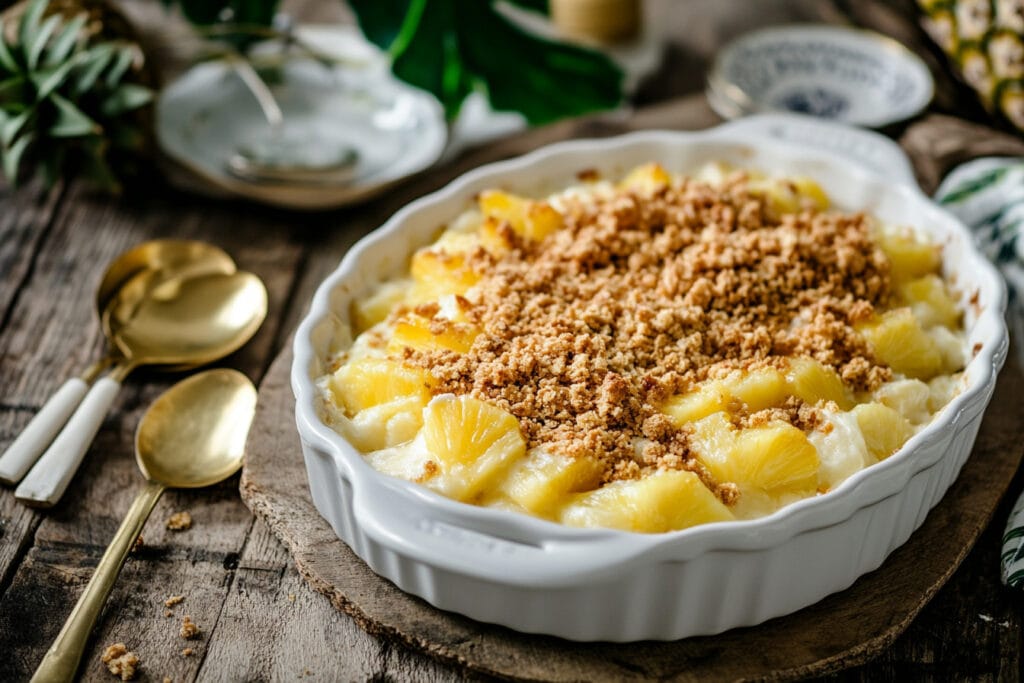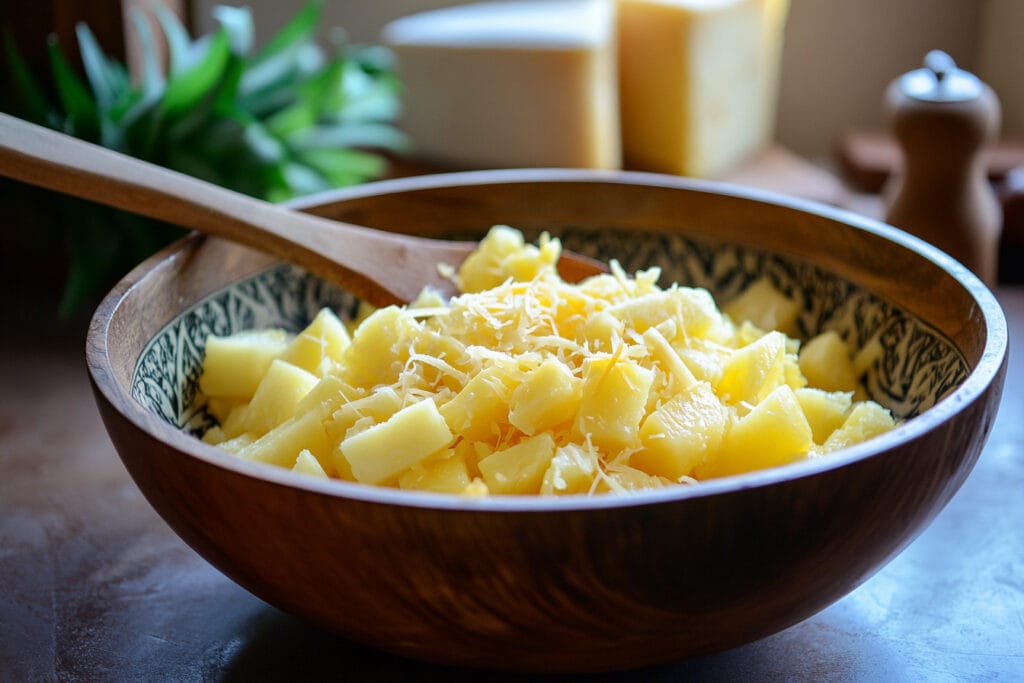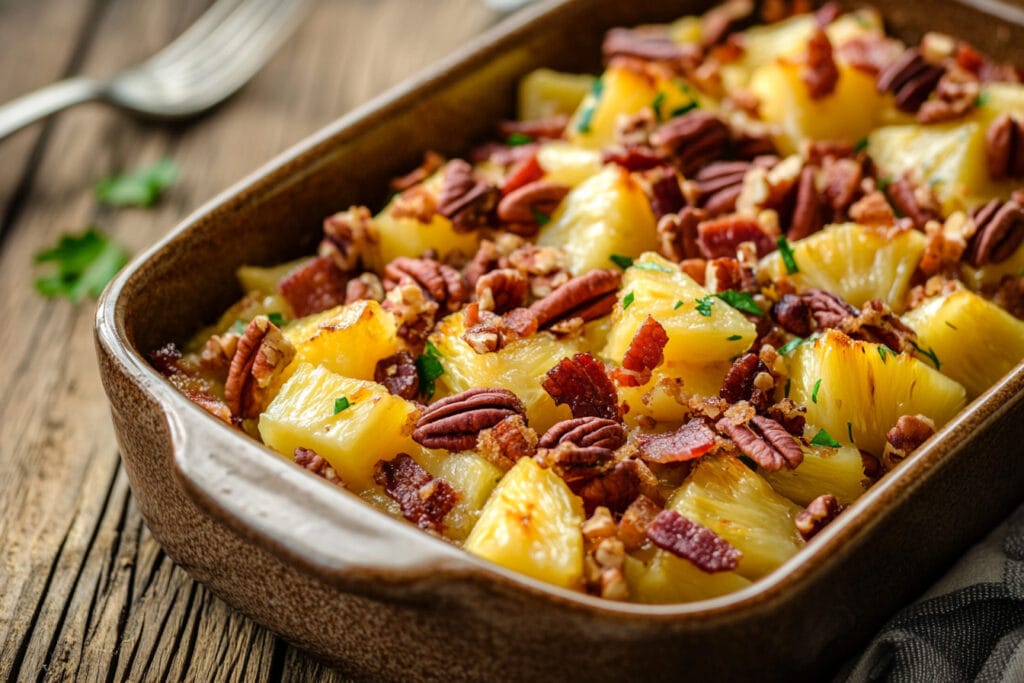
Pineapple casserole is a dish that surprises and delights with its unexpected combination of flavors. This Southern classic combines the natural sweetness of pineapple with the creamy, tangy taste of cheese and the crunch of buttery crackers, creating a culinary masterpiece that has won over countless palates. Whether served as a side dish at family gatherings, a holiday treat, or even a quirky dessert, pineapple casserole holds a special place in the hearts of those who try it.
What makes pineapple casserole so unique is its ability to blur the lines between sweet and savory. While it may sound unusual at first, the dish’s perfect balance of flavors proves that opposites truly attract. From its buttery topping to its gooey, cheesy base, pineapple casserole is more than just food—it’s an experience.
In this article, we’ll explore everything you need to know about pineapple casserole, from its history and ingredients to step-by-step preparation. You’ll also discover why this dish has become a Southern favorite, along with creative ways to adapt the recipe to suit your tastes or dietary needs. Let’s dive into the world of pineapple casserole and
What is Pineapple Casserole?
At first glance, pineapple casserole may seem like an unconventional dish. Combining sweet pineapple chunks, sharp cheddar cheese, sugar, and buttery crackers, this Southern classic is a delightful fusion of sweet and savory flavors. But what exactly is pineapple casserole, and where did it originate?
The Origins of Pineapple Casserole
Pineapple casserole has its roots in Southern American cuisine, where home cooks have long celebrated the art of mixing unexpected ingredients to create flavorful dishes. While its exact origins are somewhat unclear, this casserole gained popularity in the mid-20th century, a time when casseroles became a household staple across America. The dish was likely inspired by the abundance of canned pineapple, which became widely available and affordable during that era.
Southern cooks, known for their ingenuity, embraced the combination of pineapple’s natural sweetness with the sharpness of cheese and the buttery crunch of crackers. Over time, pineapple casserole became a favorite at church potlucks, family gatherings, and holiday feasts, cementing its place in Southern culinary tradition.
A Sweet and Savory Icon
What sets pineapple casserole apart is its versatility. While it may sound like a dessert due to its sweet pineapple and sugar content, it is often served as a side dish. The dish pairs wonderfully with savory mains like baked ham, roasted chicken, or grilled pork chops, making it a staple at Easter, Thanksgiving, and Christmas celebrations.
Its charm lies in its balance: the sweetness of pineapple is tempered by the saltiness of cheese and crackers, creating a harmonious medley of flavors. The contrasting textures—the juiciness of pineapple, the creaminess of melted cheese, and the crunch of the topping—make every bite a delightful experience.
Common Variations and Family Traditions
Like many beloved recipes, pineapple casserole has evolved over time, with families adding their own twists to make the dish their own. Some variations include the addition of pecans for extra crunch, cinnamon for warmth, or even a splash of rum for a tropical flair. Others swap out cheddar for different types of cheese, such as mozzarella or gouda, to experiment with flavor profiles.
In some households, pineapple casserole leans more toward the dessert spectrum, with extra sugar or a topping of whipped cream. In others, it stays firmly in the savory camp, with less sugar and the addition of herbs or spices. These variations speak to the dish’s adaptability and its ability to cater to diverse tastes.
Ingredients for Pineapple Casserole
Now that we’ve explored the origins and appeal of pineapple casserole, let’s take a closer look at the ingredients that make this dish so special.
Core Ingredients
The beauty of pineapple casserole lies in its simplicity. The dish typically requires just a handful of ingredients, most of which are pantry staples. Here’s a breakdown of the core components:
- Pineapple: Both canned pineapple chunks and crushed pineapple are commonly used. The canned variety provides convenience and consistent sweetness, but you can also use fresh pineapple for a brighter, tangier flavor.
- Cheese: Sharp cheddar cheese is the traditional choice for pineapple casserole. Its bold, tangy flavor contrasts beautifully with the sweetness of the pineapple, creating a rich and satisfying taste.
- Crackers: Buttery crackers like Ritz are a key element of the dish, forming a golden, crispy topping that adds texture and a hint of saltiness.
- Sugar: Granulated sugar enhances the natural sweetness of the pineapple, tying the flavors together.
- Butter: Melted butter binds the cracker topping and adds a luxurious richness to the dish.
Optional Add-Ins
For those looking to customize their pineapple casserole, there are plenty of ways to elevate the dish with additional ingredients. Here are a few popular add-ins:
- Nuts: Chopped pecans or walnuts can be sprinkled into the topping for added crunch and nuttiness.
- Cinnamon: A dash of cinnamon brings warmth and depth, especially if you’re leaning toward a dessert-style casserole.
- Vanilla Extract: A touch of vanilla can enhance the sweetness and aroma of the dish.
- Beef: For a heartier version, consider adding diced crumbled beef, which pair beautifully with the pineapple and cheese.
The Importance of Ingredient Quality
While pineapple casserole is a simple dish, the quality of the ingredients can make a significant difference in the final result. Opt for high-quality cheese and fresh, buttery crackers to ensure the best flavor and texture. If you’re using fresh pineapple, make sure it’s fully ripe to bring out its natural sweetness.
Step-by-Step Recipe for Pineapple Casserole
Making pineapple casserole is an incredibly straightforward process, even for novice cooks. Its simplicity, combined with its crowd-pleasing flavors, is part of what makes this dish a staple in so many households. Below, you’ll find a detailed, step-by-step guide to preparing this Southern classic.
Preparation Process
Before diving into the assembly, make sure you have all your ingredients prepped and your kitchen tools ready. Here’s what you’ll need:
Ingredients
- 2 cans (20 ounces each) of pineapple chunks or crushed pineapple, drained (reserve a bit of the juice)
- 1 cup granulated sugar
- 1 cup shredded sharp cheddar cheese
- 1 cup crushed buttery crackers (about 1 sleeve of Ritz crackers)
- ½ cup melted unsalted butter
Optional Add-Ins
- ½ cup chopped pecans or walnuts (for extra crunch)
- 1 teaspoon cinnamon (for a touch of spice)
Tools
- Mixing bowls
- A whisk or spoon for stirring
- A greased 9×13-inch baking dish
- Measuring cups and spoons
Preheat the Oven
Begin by preheating your oven to 350°F (175°C). Preheating ensures that the casserole cooks evenly and achieves the perfect golden crust on top.
Prepare the Pineapple Mixture
In a large mixing bowl, combine the drained pineapple chunks or crushed pineapple, granulated sugar, and shredded cheddar cheese. Stir the mixture until all the ingredients are evenly distributed. If you want to balance the sweetness with a hint of tang, you can add a tablespoon or two of the reserved pineapple juice.

Assemble the Casserole
Transfer the pineapple mixture into your greased 9×13-inch baking dish, spreading it out evenly. The layer should be compact but not overly pressed, allowing the topping to settle naturally on top.
Prepare the Cracker Topping
In a separate bowl, combine the crushed buttery crackers and melted butter. If you’re adding chopped pecans or cinnamon, mix them into the topping at this stage. Stir until the crackers are fully coated in butter, forming a crumbly, cohesive topping.
Add the Topping
Sprinkle the cracker mixture evenly over the pineapple mixture in the baking dish. Be sure to cover the entire surface so that each bite of casserole has a balance of creamy filling and crunchy topping.
Bake the Casserole
Place the casserole in your preheated oven and bake for 25-30 minutes, or until the topping is golden brown and crisp. The filling should be bubbling slightly around the edges. Keep an eye on it toward the end of the cooking time to prevent the topping from over-browning.
Let It Cool and Serve
Once baked, remove the casserole from the oven and let it cool for about 5-10 minutes. This resting time allows the flavors to meld and makes it easier to serve. Use a large spoon to scoop portions onto plates, and enjoy your delicious pineapple casserole!
Tips for Achieving the Perfect Casserole
Creating a perfect pineapple casserole requires a little finesse, but these tips can help ensure your dish is a hit every time:
- Don’t Overmix the Filling: Stirring the pineapple mixture too vigorously can break down the fruit and create a mushy texture. Gentle mixing is key.
- Use Freshly Shredded Cheese: Pre-shredded cheese may contain additives that prevent it from melting smoothly. For the best results, shred your cheddar cheese fresh from a block.
- Crush Crackers Consistently: For an even topping, crush the crackers into small, uniform pieces. Avoid leaving large chunks, as they may burn during baking.
- Customize the Sweetness: If you prefer a less sweet dish, reduce the amount of sugar or substitute it with honey or maple syrup for a natural alternative.
- Bake Just Right: Avoid overbaking the casserole, as the topping may become too hard. The casserole is done when the topping is golden and the filling is bubbling.
Sweet and Savory Fusion: Why It Works
Pineapple casserole is more than just a quirky recipe—it’s a testament to the art of balancing contrasting flavors. But why does this unique combination of sweet and savory flavors work so well? Let’s explore the culinary magic behind it.
The Science of Sweet and Savory Flavors
The combination of sweet and savory flavors has long been celebrated in culinary traditions worldwide. Pineapple casserole is no exception, as it capitalizes on the contrast between sugary, tangy pineapple and rich, salty cheddar cheese. This balance of flavors stimulates multiple taste receptors on the palate, creating a more dynamic and satisfying eating experience.
At the heart of this pairing is umami, the savory taste sensation found in cheese. The saltiness and creaminess of the cheddar enhance the sweetness of the pineapple, while the fruit’s natural acidity cuts through the richness of the cheese, preventing the dish from feeling heavy.
How Pineapple Enhances Other Ingredients
Pineapple is a versatile fruit that pairs beautifully with a wide range of ingredients. In pineapple casserole, its tangy sweetness complements the sharpness of the cheese and the buttery crackers, tying all the elements together. Pineapple also brings moisture to the dish, ensuring that the filling stays creamy and luscious throughout baking.
Beyond its flavor, pineapple contributes a vibrant golden hue to the casserole, making the dish visually appealing. Its tropical aroma adds another layer of sensory delight, making pineapple casserole a feast for the eyes, nose, and taste buds.

FAQs About Pineapple Casserole
Pineapple casserole is a dish that often raises questions for first-time tasters and cooks alike. From its unique combination of ingredients to its versatility, here are answers to some of the most frequently asked questions about this beloved Southern classic.
Is pineapple casserole a dessert or a side dish?
This is perhaps the most common question about pineapple casserole—and the answer depends on how it’s served. Traditionally, pineapple casserole is enjoyed as a side dish, especially in Southern cuisine. It pairs wonderfully with savory mains like baked ham, roasted turkey, or fried chicken.
However, its sweet and fruity flavor also makes it a candidate for dessert. Some families even tweak the recipe to make it sweeter, adding cinnamon or vanilla extract to give it a more dessert-like appeal. Ultimately, pineapple casserole is versatile enough to be enjoyed as either a side dish or a dessert, depending on your preferences and the meal it accompanies.
Can pineapple casserole be made ahead of time?
Yes! Pineapple casserole is an excellent make-ahead dish, making it a popular choice for holidays and gatherings. To prepare it in advance, follow these steps:
- Assemble the casserole as instructed, but hold off on adding the cracker topping.
- Cover the dish with foil or plastic wrap and refrigerate for up to 24 hours.
- When you’re ready to bake, add the cracker topping, and bake as directed. If baking straight from the refrigerator, you may need to add an extra 5-10 minutes to the cooking time.
Making it ahead not only saves time but also allows the flavors to meld, resulting in an even more delicious dish.
Related: Check out this guide on delicious crescent roll breakfast recipes for more make-ahead ideas.
What are the best crackers to use?
Buttery crackers like Ritz are the gold standard for pineapple casserole. Their rich, slightly salty flavor perfectly complements the sweet pineapple and sharp cheddar cheese. Ritz crackers also crumble easily and create a golden, crispy topping when baked.
If you’re looking for alternatives, try graham crackers for a sweeter twist or whole-grain crackers for a healthier option. Avoid using overly salty crackers, as they can overpower the dish’s delicate balance of flavors.
You might also like: Learn about key differences between puff pastry and crescent rolls.
Can pineapple casserole be frozen and reheated?
Yes, pineapple casserole can be frozen, although it’s best to freeze it before baking for optimal texture. To freeze:
- Assemble the casserole without the cracker topping.
- Wrap the dish tightly in plastic wrap, then cover it with aluminum foil to prevent freezer burn.
- Freeze for up to 2 months.
When you’re ready to serve, thaw the casserole in the refrigerator overnight. Add the cracker topping and bake as directed. While reheated pineapple casserole is still delicious, the topping may lose some of its crispness after freezing. To refresh it, sprinkle on a bit of extra crushed crackers before reheating.
Cooking Tip: For more freezer-friendly dishes, see this article on freezing chicken and dressing.
What cheeses work best in pineapple casserole?
Sharp cheddar cheese is the traditional choice for pineapple casserole, as its bold, tangy flavor cuts through the sweetness of the pineapple and sugar. However, you can experiment with other cheeses to create different flavor profiles:
- Mild Cheddar: For a less intense flavor, use mild cheddar instead of sharp.
- Mozzarella: Adds a gooey texture and a more neutral flavor.
- Gouda: Its smoky undertones can add depth to the dish.
- Cream Cheese: For a creamier filling, mix in softened cream cheese with the pineapple.
While experimenting with different cheeses can be fun, make sure the cheese you choose melts well and complements the sweetness of the pineapple.
Explore: Try this ultimate branzino recipe for another bold and flavorful dish.
How can I adapt it for food allergies?
Pineapple casserole can be adapted to accommodate various dietary restrictions and allergies. Here’s how:
Nut-Free: Avoid adding nuts to the topping if there’s a risk of nut allergies.
Gluten-Free: Use gluten-free crackers or breadcrumbs for the topping.
Dairy-Free: Replace the cheese with a dairy-free alternative and use vegan butter in place of regular butter.
Conclusion
Pineapple casserole is more than just a recipe—it’s a testament to the creativity and warmth of Southern cooking. With its unique combination of sweet pineapple, savory cheese, and buttery crackers, it’s a dish that surprises, delights, and leaves a lasting impression. Whether served as a side dish, dessert, or the centerpiece of a potluck table, pineapple casserole has a way of bringing people together and sparking conversations.
As we’ve explored in this article, pineapple casserole is endlessly adaptable. From adding meats like beef to experimenting with different cheeses or toppings, there’s no shortage of ways to make this dish your own. Whether you stick with the classic recipe or create a personalized variation, pineapple casserole is sure to become a favorite in your home.
